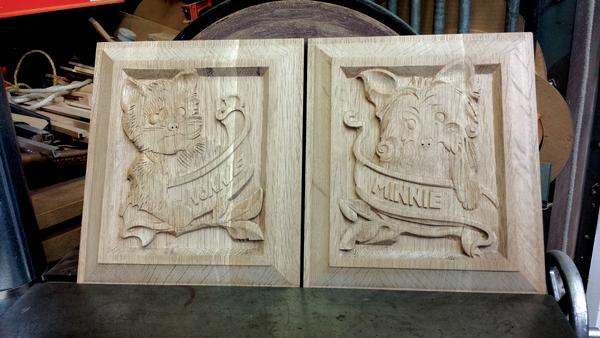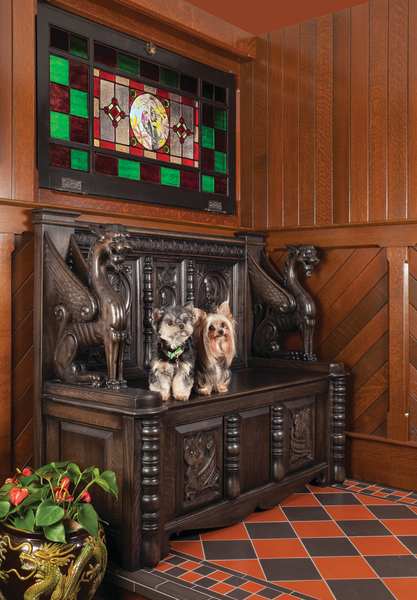
Of unknown provenance, the salvaged scraps included a pair of carved-griffin support brackets that had probably come from a sideboard, and a Jacobean Revival oak panel found in England. The griffins had been painted and, under the paint, weathered to a dull grey, and the panel had nail holes and insect damage.
Nevertheless, they were the impetus for the design of my back-hall bench—a place to store boots and dog leashes. Two feet wide, the English carved panel would make a perfect back; the griffins would become side arms. Inspired by country houses I’ve toured in England, I decided to have my Yorkies’ likenesses carved into the apron below the seat.
Furniture-maker Stephen Hultberg and I pored over period catalogs filled with Gothic coffers, hall and church benches, to come up with a design to tie together old pieces and new oak.

Creating the Bench
1. Prep
To ensure perfect fit, the design was drawn full-scale on fiberboard. Quarter-sawn white oak (kiln-dried) in 1″- and 2″- thick stock was purchased for making new legs, rails, and panels. The salvaged bits were stripped, smoothed with #2 steel wool, and cleaned with lacquer thinner to get down to bare wood.
2. Construction
The lower part of the bench was constructed first: four thick legs typical of Gothic benches with back legs rising to the top of the bench to stabilize the griffins’ wings (and prevent clothing snags).
The dogs’ faces were carved into two of the raised panels. (A enlarged photo of each was glued to fiberboard that was then cut out and attached to the panel blanks. Outlines were traced with a pin router, the fiberboard removed, and finally the carving done by hand with chisels and gouges.)
3. Finishing
After construction, the bench was sanded with an orbital sander using 120 grit aluminum-oxide discs, and finally by hand. A colored paste wood filler was applied with a stiff brush, removed immediately with a plastic spatula, and then wiped across grain with burlap.
A synthetic black dye thinned 30 percent with denatured alcohol was applied to the wood, then quickly wiped off with a clean cotton rag to pre-finish it.
The pieces were glued together with woodworker’s yellow aliphatic glue (TiteBond), held in place with steel bar clamps overnight.
A coat of clear lacquer sanding sealer was sprayed over the bench, then sanded by hand. A glaze made of lampblack pigments (to combat UV fading) was mixed and applied. Final finish is three sprayed topcoats of 50/50 semi-gloss and flat nitrocellulose lacquer, hand sanded between each coat.







